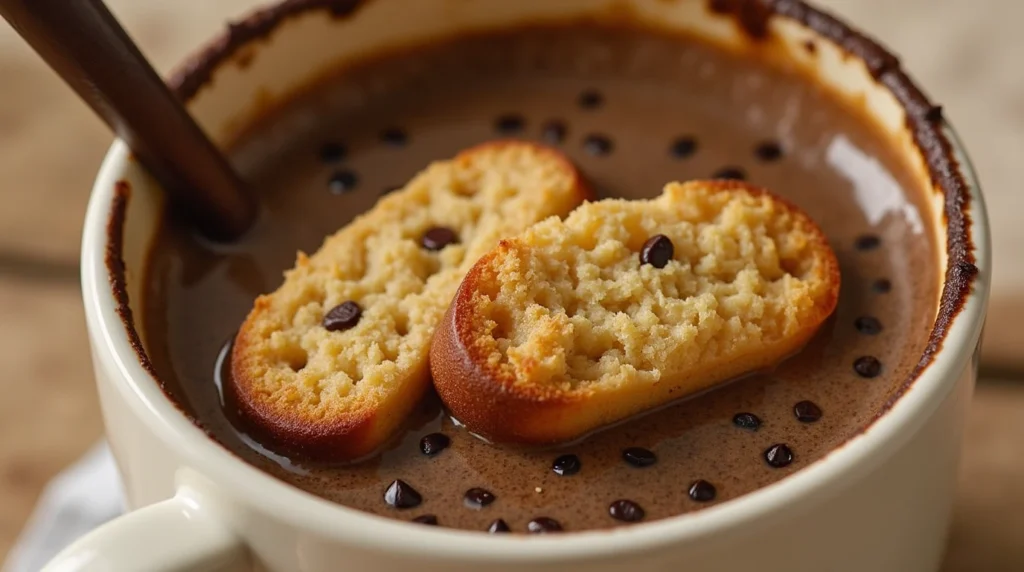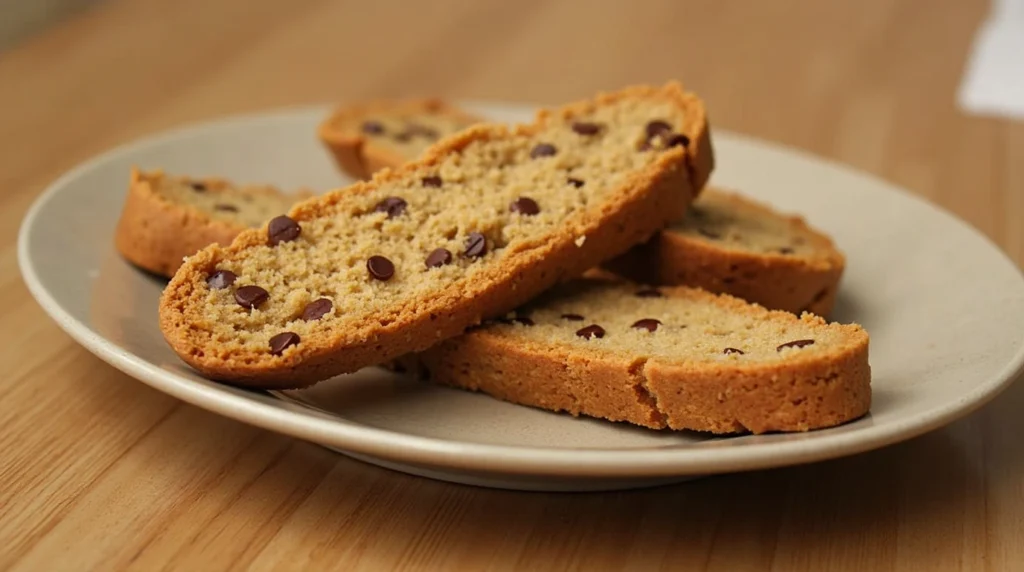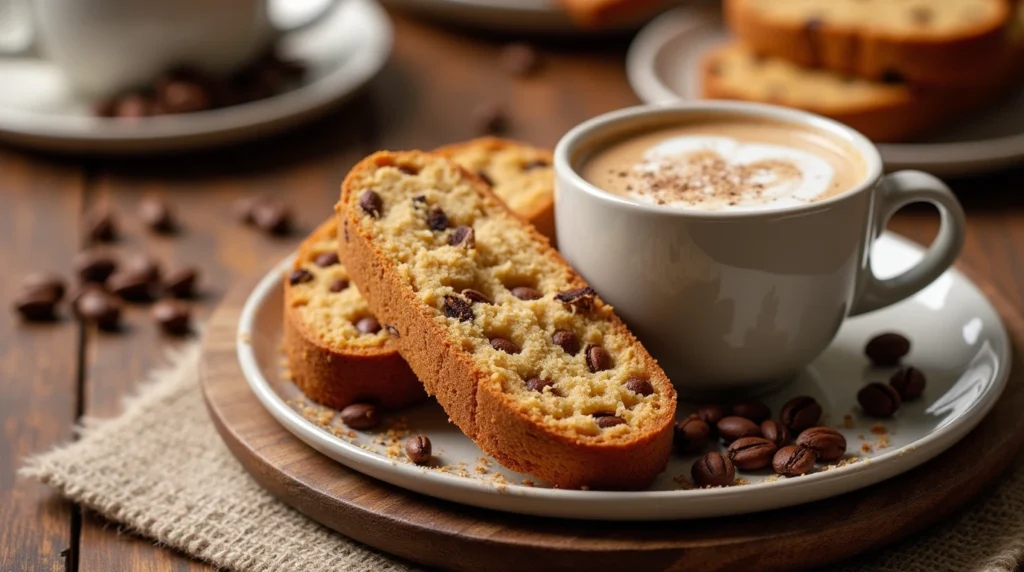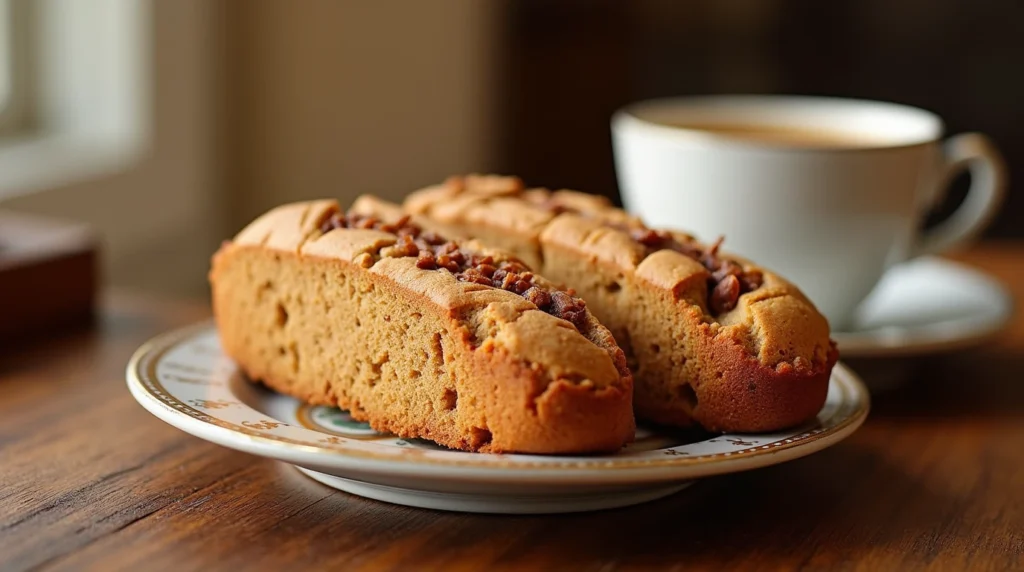Introduction

The Magic of Espresso Biscotti
There’s something truly magical about biting into a crisp, aromatic biscotti infused with the rich flavor of espresso. Imagine savoring this delightful treat while enjoying your favorite cup of coffee or tea—it’s pure bliss! But did you know that creating these delectable Italian cookies in your own kitchen is easier than you think? With this comprehensive guide, we’ll walk you through every step, from preparation to presentation, ensuring your espresso biscotti turns out perfectly every time.
Opening Reflection:
Have you ever found yourself longing for a bakery-quality dessert but feeling overwhelmed by the idea of baking it yourself? Trust me, I’ve been there too. That was until I discovered how simple and rewarding it is to bake espresso biscotti at home. Not only does it save money, but it also allows you to customize flavors according to your taste preferences. Whether you’re hosting friends or treating yourself, mastering this recipe will leave everyone asking for seconds—and maybe even thirds!
Understanding Espresso Biscotti
What Makes Espresso Biscotti Unique?
Espresso biscotti stands out due to its bold coffee flavor and satisfying crunch. Here’s what makes it special:
- Twice-Baked Perfection: Unlike regular cookies, biscotti undergoes two rounds of baking, resulting in its characteristic hardness.
- Cultural Roots: Originating in Italy, biscotti has long been cherished as an accompaniment to beverages like cappuccino or wine.
- Versatility: Its neutral base pairs beautifully with various toppings and mix-ins, making it endlessly customizable.
Key Ingredients for Success
To achieve authentic results, focus on quality ingredients:
- Almonds: Add crunch and nuttiness; blanched almonds work best.
- Flour & Sugar: All-purpose flour creates structure, while granulated sugar adds sweetness.
- Eggs: Act as binders and contribute moisture.
- Espresso Powder/Extract: Elevates the flavor profile significantly.
- Optional Extras: Chocolate chips, vanilla extract, or spices can enhance the taste further.
| Ingredients | Quantity |
|---|---|
| All-purpose flour | 2 cups |
| Granulated sugar | 1 cup |
| Eggs | 3 large |
| Almond extract | 1 tsp |
| Espresso powder | 2 tbsp |
| Salt | 1/4 tsp |
Tools You’ll Need
Before diving in, gather these essential tools:
- Mixing bowls
- Spatula
- Measuring cups/spoons
- Parchment paper or silicone mat
- Cooling rack
- Sharp knife (for slicing logs)
Pro tip: Invest in an oven thermometer to ensure accurate temperature readings during baking.
Step-by-Step Guide to Making Espresso Biscotti
Preparing the Dough
Start by combining dry and wet ingredients:
- In one bowl, whisk together flour, salt, and espresso powder.
- In another bowl, beat eggs, sugar, almond extract, and optional extras until creamy.
- Gradually incorporate dry ingredients into the wet mixture until a soft dough forms.
- Let the dough rest for 10 minutes to relax gluten strands.

Shaping the Biscotti
Shape the dough into logs before the first bake:
- Divide the dough into two equal portions.
- Roll each portion into a log about 12 inches long and 2 inches wide.
- Place logs onto a prepared baking sheet, leaving space between them.
Baking Twice for Perfection
Follow these steps for optimal texture:
- Bake the logs at 350°F (175°C) for 25 minutes or until golden brown.
- Remove from the oven and let cool slightly.
- Slice the logs diagonally into 1/2-inch thick pieces using a sharp knife.
- Arrange slices flat-side down on the baking sheet.
- Reduce heat to 325°F (165°C) and bake for another 15–20 minutes per side.
Cooling and Storing
Once baked, allow the biscotti to cool completely:
- Transfer slices to a wire rack for cooling.
- Store in an airtight container at room temperature for up to two weeks.
- For longer storage, freeze individually wrapped biscotti for up to three months.
Flavor Variations and Customizations
Adding Chocolate Drizzle
Enhance your biscotti with decadent chocolate:
- Melt dark or milk chocolate over low heat.
- Dip the ends of cooled biscotti into the melted chocolate.
- Decorate with sprinkles or nuts before the chocolate hardens.
Nut-Free Options
If you have nut allergies, consider these alternatives:
- Replace almonds with seeds like sunflower or pumpkin.
- Use oat flour instead of almond flour for added texture.
Vegan Espresso Biscotti
Make your recipe plant-based friendly:
- Substitute eggs with flaxseed meal mixed with water.
- Swap granulated sugar with coconut sugar or maple syrup.
Spiced Versions
Infuse warmth with spices:
- Mix cinnamon, nutmeg, or ginger into the dough.
- Pair spiced biscotti with herbal teas or spiced lattes for a cozy experience.
Serving Suggestions and Pairings
Perfect Drinks to Pair With
Complement your biscotti with complementary drinks:
- Black coffee or espresso for classic pairing.
- Herbal teas or hot cocoa for a sweeter option.
- Dessert wines like Vin Santo for a luxurious touch.
Dessert Platter Ideas
Create visually appealing spreads:
- Arrange biscotti alongside fresh fruits, cheeses, or jams.
- Dust with powdered sugar for elegance.
Gifting Opportunities
Turn biscotti into thoughtful gifts:
- Package in decorative tins or jars.
- Attach personalized tags with baking details.
Troubleshooting Common Issues
Why Are My Biscotti Too Soft?
Soft biscotti may result from:
- Underbaking during the second round.
- Insufficient drying time after slicing.
Cracked Logs During Shaping
Prevent cracks by:
- Handling dough gently without overworking it.
- Ensuring proper hydration levels.
Uneven Baking Results
Achieve uniformity by:
- Rotating pans halfway through baking.
- Checking oven calibration regularly.
Flavor Too Mild?
Boost intensity by:
- Increasing espresso powder quantity.
- Using freshly ground coffee beans.
Advanced Techniques for Perfect Espresso Biscotti
Mastering Dough Consistency
Achieving the right dough consistency is crucial for successful biscotti. Here’s how:
- Hydration Balance: If your dough feels too dry, add a teaspoon of milk or water gradually. Conversely, if it’s sticky, sprinkle in a little extra flour.
- Resting Time: Allowing the dough to rest for 10–15 minutes helps relax gluten strands, making it easier to shape without cracking.

Enhancing Flavor Profiles
Take your espresso biscotti to the next level with these flavor-enhancing techniques:
- Freshly Ground Coffee Beans: Using freshly ground coffee instead of pre-packaged espresso powder can elevate the aroma and taste.
- Citrus Zest: Adding a hint of lemon or orange zest introduces brightness that complements the rich coffee notes.
- Spices & Extracts: Experiment with complementary flavors like vanilla bean paste, cinnamon, or cardamom for added complexity.
Achieving Uniform Slicing
Proper slicing ensures even baking and presentation:
- Chill Before Cutting: Place the baked logs in the refrigerator for 10 minutes before slicing. This firms up the dough, preventing crumbling.
- Sharp Knife Technique: Use a serrated knife for clean cuts. Apply gentle pressure and saw back and forth rather than pressing down forcefully.
Creative Presentation Ideas
Decorating Your Biscotti
Presentation matters, especially when gifting or serving at gatherings. Try these ideas:
- Dipping Variations: Besides chocolate, try caramel or white chocolate drizzles for variety.
- Sprinkles & Toppings: Add festive touches with crushed nuts, sprinkles, or shredded coconut.
- Edible Glitter: Dust biscotti with edible glitter or gold leaf for a luxurious look.
Themed Platters
Create themed dessert platters based on occasions:
- Holiday Platter: Combine peppermint-flavored biscotti with red and green decorations for Christmas cheer.
- Summer Vibes: Serve biscotti alongside fresh berries and whipped cream for a refreshing summer treat.
- Coffee Lover’s Spread: Pair biscotti with different types of coffee beans, grounds, and brewing tools for a coffee enthusiast’s dream gift.
Healthier Alternatives
Reducing Sugar Content
For those watching their sugar intake, consider these alternatives:
- Natural Sweeteners: Replace granulated sugar with honey, maple syrup, or stevia for a lower glycemic index option.
- Fruit Purees: Applesauce or mashed bananas can act as natural sweeteners and binders.
Gluten-Free Espresso Biscotti
Make your recipe inclusive by going gluten-free:
- Substitute all-purpose flour with almond flour, oat flour, or a gluten-free blend.
- Adjust liquid quantities slightly, as gluten-free flours absorb moisture differently.
Low-Calorie Options
Lighten up your biscotti without sacrificing flavor:
- Use egg whites instead of whole eggs to reduce fat content.
- Incorporate fiber-rich ingredients like chia seeds or flaxseeds for added nutrition.
Troubleshooting Deep Dive
Preventing Overbrowning
Overbrowning often occurs due to high oven temperatures or prolonged baking times:
- Monitor your oven closely during the second bake.
- Rotate trays halfway through to ensure even heat distribution.
Avoiding Burnt Edges
Edges tend to burn faster than the center pieces:
- Space out slices evenly on the baking sheet.
- Cover edges loosely with foil if they start browning too quickly.
Fixing Uneven Shapes
If your biscotti comes out uneven, here’s what you can do:
- Ensure consistent log thickness before the first bake.
- Slice each piece uniformly after cooling slightly.
Fun Facts About Espresso Biscotti
Historical Background
Did you know that biscotti dates back to Roman times? Originally called “biscoctus,” meaning “twice-cooked,” it was designed as durable rations for soldiers and sailors. Over centuries, Italians refined the recipe, transforming it into the beloved dessert we know today.
Regional Variations
Different regions in Italy have their own takes on biscotti:
- Tuscan Style: Often plain or lightly flavored, focusing on simplicity.
- Venetian Twist: Includes candied fruits or spices for extra flair.
Modern Adaptations
Today, biscotti has evolved beyond its traditional roots:
- Flavors range from matcha to lavender.
- Unique shapes, such as hearts or stars, make them fun for special occasions.
Community Engagement and Inspiration
Join Online Groups
Connect with fellow biscotti enthusiasts by joining online communities:
- Platforms like Reddit, Facebook groups, and Instagram hashtags (#EspressoBiscotti) offer inspiration and support.
- Share your creations and learn new tricks from experienced bakers worldwide.
Host a Baking Challenge
Engage friends and family with a friendly competition:
- Set themes like “Most Creative Flavor” or “Best Presentation.”
- Award prizes for the winning entries to keep things exciting.
The Science Behind Baking Espresso Biscotti
Why Twice-Baked Matters
The twice-baking process is what defines biscotti’s unique texture. Here’s why it works:
- Moisture Reduction: The first bake sets the structure, while the second removes excess moisture, creating a crunchy exterior.
- Flavor Concentration: As moisture evaporates during the second bake, flavors intensify, leaving behind a robust coffee aroma.
- Longevity: Reduced moisture content increases shelf life, making biscotti ideal for gifting or long-term storage.
Role of Leavening Agents
While traditional biscotti recipes don’t use leavening agents like baking powder or soda, incorporating small amounts can enhance texture:
- Lighter Crumb: A pinch of baking powder helps create a slightly softer interior without compromising crunchiness.
- Balanced Rise: Be cautious—too much leavening can cause the biscotti to crumble instead of holding their shape.
Oven Temperature Precision
Understanding your oven’s quirks is essential for consistent results:
- Hot Spots: Rotate trays halfway through baking to account for uneven heat distribution.
- Preheating: Always preheat your oven fully before starting. Cold ovens can lead to underbaked biscotti.
Pairing Espresso Biscotti with Drinks
Coffee Combinations
Espresso biscotti pairs naturally with various coffee drinks:
- Espresso Shots: For a bold match that highlights the biscotti’s flavor.
- Cappuccino: Frothy milk balances the biscotti’s crunch and richness.
- Latte Macchiato: A creamy, layered drink that complements the biscotti beautifully.
Tea Alternatives
For non-coffee drinkers, tea offers delightful pairings:
- Earl Grey: Citrus notes in Earl Grey complement the biscotti’s nutty undertones.
- Chai Latte: Spiced chai provides warmth and complexity.
- Green Tea: Light and refreshing, green tea contrasts nicely with the biscotti’s density.
Batch Size Adjustments
Scaling Up for Large Gatherings
Planning to make biscotti for a crowd? Scale up your recipe proportionally:
- Multiply ingredient quantities by the desired factor (e.g., double for two batches).
- Use multiple baking sheets to accommodate larger quantities without overcrowding.
Mini Biscotti for Snack Portions
Create bite-sized versions perfect for parties:
- Slice logs thinner (about 1/4 inch thick) for mini biscotti.
- Reduce second bake time slightly to prevent over-drying.
Freezing Unbaked Logs
Prepare ahead of time by freezing unbaked biscotti logs:
- Wrap tightly in plastic wrap and store in freezer bags.
- When ready to bake, thaw overnight in the refrigerator and proceed as usual.

Educational Resources for Aspiring Bakers
Online Courses and Tutorials
Enhance your skills with expert guidance:
- Platforms like Udemy, Skillshare, and YouTube offer comprehensive baking courses tailored to beginners and advanced bakers alike.
- Look for tutorials specifically focused on biscotti techniques for targeted learning.
Books and Cookbooks
Expand your knowledge with trusted resources:
- “Biscotti: The Classic Italian Cookie” by Carol Field – A definitive guide to mastering biscotti.
- “The Joy of Cooking” – Includes classic biscotti recipes along with troubleshooting advice.
Podcasts and Blogs
Stay inspired with regular updates from passionate bakers:
- Listen to podcasts like The Baking Show for interviews with industry experts.
- Follow blogs dedicated to baking science and innovation for fresh ideas.
Troubleshooting Beyond Basics
Addressing Dough Issues
Common dough problems and solutions:
- Too Sticky: Gradually add flour until the dough becomes manageable.
- Too Dry: Incorporate a teaspoon of milk or water at a time until smooth.
- Cracking During Shaping: Knead gently and chill the dough briefly before rolling.
Preventing Overcrowding
Overcrowded baking sheets lead to uneven baking:
- Leave at least 1 inch of space between slices.
- Bake in batches if necessary to avoid overlapping.
Fixing Uneven Coloring
If some pieces brown faster than others:
- Rotate the tray halfway through the second bake.
- Shield darker edges with aluminum foil to prevent burning.
Sustainability in Baking
Eco-Friendly Practices
Reduce waste and environmental impact with these tips:
- Use Reusable Tools: Opt for silicone mats instead of single-use parchment paper.
- Buy in Bulk: Purchase ingredients like flour and sugar in bulk to minimize packaging.
- Compost Scraps: Dispose of eggshells and leftover dough responsibly.
Supporting Local Suppliers
Choose locally sourced ingredients whenever possible:
- Freshly roasted coffee beans from nearby roasters add depth to your biscotti.
- Buying local supports small businesses and reduces carbon footprints.
FAQ Section
Q1: Can I make espresso biscotti without almonds?
Absolutely! Replace almonds with seeds or omit entirely for a nut-free version.
Q2: Is it possible to freeze espresso biscotti?
Yes, freezing is ideal for long-term storage. Wrap individual pieces tightly in plastic wrap and place in freezer bags.
Q3: How do I adjust the recipe for vegan espresso biscotti?
Substitute eggs with flaxseed gel and use plant-based sweeteners like agave nectar.
Q4: Why does my biscotti turn out too soft?
Ensure adequate baking time during both rounds and allow sufficient cooling afterward.
Conclusion
Recap and Encouragement
Making delicious espresso biscotti at home doesn’t require advanced skills—just patience and attention to detail. By following this guide, you’ll create mouthwatering treats tailored to your liking. Don’t hesitate to experiment with variations and share your creations with loved ones. After all, baking is not just about food; it’s about creating memories.
